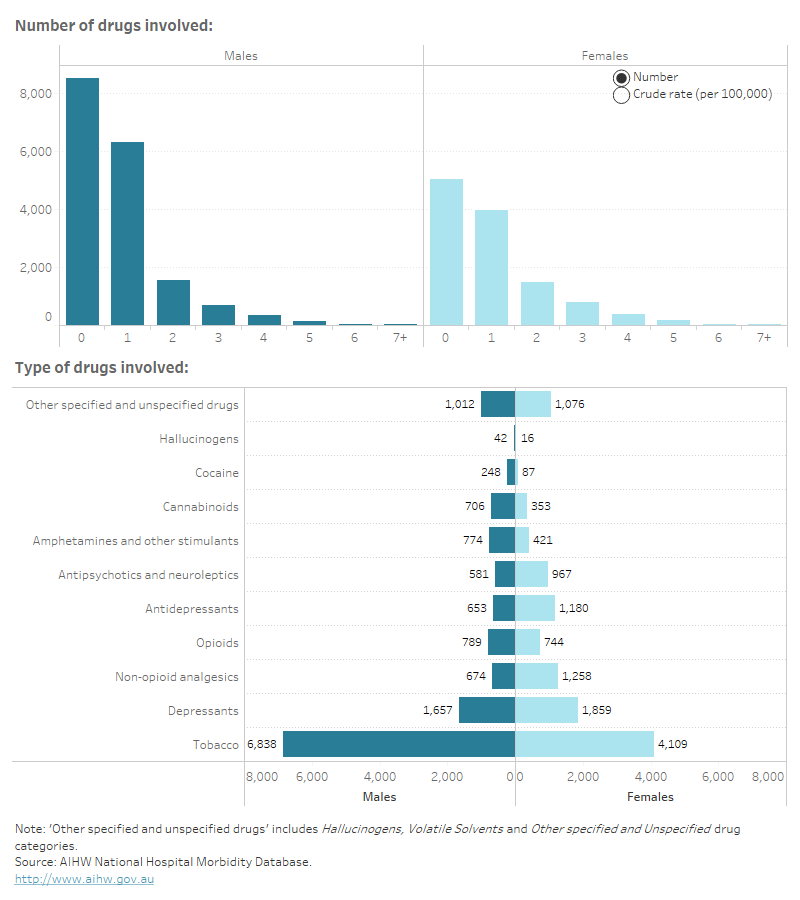Presence of other drugs
Polydrug use, which is use of multiple prescription, over-the-counter or street drugs was observed in the data, with 55% (16,400) of cases recording the presence of other drugs in addition to alcohol (Table 2). Tobacco was the most commonly recorded drug, reported in 36% (11,000) of alcohol-related injury hospitalisations.
|
Number and type of drugs |
Number |
% |
|---|---|---|
|
Alcohol only |
13,598 |
45.3 |
|
Alcohol and tobacco |
7,565 |
25.2 |
|
Alcohol, tobacco and 1 other drug |
1,722 |
5.7 |
|
Alcohol, tobacco and 2 other drugs |
814 |
2.7 |
|
Alcohol, tobacco and 3 or more other drugs |
847 |
2.8 |
|
Alcohol and 1 other drug (tobacco not recorded) |
2,771 |
9.2 |
|
Alcohol and 2 other drugs (tobacco not recorded) |
1,363 |
4.5 |
|
Alcohol and 3 or more other drugs (tobacco not recorded) |
1,344 |
4.5 |
|
Total |
30,024 |
100 |
Note: Percentage may not total to 100 due to rounding.
Source: AIHW National Hospital Morbidity Database.
Rates at which the use of other drugs were recorded were similar between smokers and non-smokers who had been hospitalised for an alcohol-related injury (Table 3).
Drugs other than alcohol and tobacco
There were around 8,900 (30%) alcohol-related hospitalisations where more than one drug in addition to alcohol was recorded, regardless of tobacco use (Table 3; see below for drug type categories). Among these cases, there were 15,100 records of use of these drugs – an average of 1.7 drugs other than alcohol or tobacco per hospitalisation. Depressants (23%, 3,500) were the most commonly identified drug category but there were over 1,000 cases that recorded use of non-opioid analgesics, antidepressants, amphetamines and other stimulants, anti-psychotics and neuroleptics, cannabinoids, or opioids.
|
Number of drugs |
Smokers (%) |
Non-smokers (%) |
|---|---|---|
|
Alcohol and 1 other drug |
15.7 |
14.5 |
|
Alcohol and 2 other drugs |
7.4 |
7.1 |
|
Alcohol and 3 or more other drugs |
7.7 |
7.0 |
|
Alcohol only |
69.1 |
71.3 |
|
Total |
36.5 |
63.5 |
Source: AIHW National Hospital Morbidity Database.
Box 7: Drug type categories
The hospitalisation data from the NHMD contains ICD-10-AM codes that identify types and categories of drugs. These codes have been grouped by type of drug for the following analysis. The types of drugs included in these categories are outlined below (Alcohol and Drug Foundation 2022).
Depressants: includes antiepileptic, sedative, hypnotic and anti-parkinsonism drugs, including benzodiazepines (for example, Xanax, Valium) and gamma hydroxybutyrate (GHB).
Tobacco: consumption methods include smoking of cigarettes, cigars, pipes and waterpipes (for example, hookah) and chewing. Contains nicotine which is its addictive component. (ACCD 2019, AIHW 2022).
Non-opioid analgesics: typically used for pain management. Examples include paracetamol, aspirin and ibuprofen (NEJM Knowledge+ 2019).
Opioids: commonly prescribed for pain management or used as a street drug. Examples include: codeine, fentanyl, heroin, methadone, morphine, oxycodone.
Antidepressants: medications used to treat depression and its symptoms. Examples include: Prozac and citalopram (Healthdirect 2021).
Antipsychotics and neuroleptics: used to treat mental health problems such as schizophrenia, bipolar disorder, severe depression or personality disorder. Examples include: chlorpromazine and fluanxol (CAMH 2022).
Amphetamines and other stimulants: psychostimulants that increase the messages between the body and the brain, commonly prescribed to treat ADHD and Parkinson’s disease. Some amphetamines are sold illegally, for example speed or crystal methamphetamine (also known as ice). Excludes cocaine, which has its own category.
Cannabinoids: used for recreational, medicinal and synthetic purposes that can have a psychoactive or anti-psychoactive effect. The most common cannabinoid is marijuana.
Cocaine: a stimulant that is most commonly a street drug.
Other specified and unspecified drugs: all other drugs not included in the above categories. Includes anaesthetics, drugs affecting the cardiovascular, gastrointestinal or hormonal systems, haematological agents, antibiotics, vaccines, water-balance agents and drugs affecting mineral and uric acid metabolism.
The ICD-10-AM coding of drugs is subject to the same limitations as alcohol coding, these are outlined in the methods section.
For more information on the codes forming each type of drug see Technical notes.
Figure 5 shows differences between males and females by the type of drug present.
Figure 5: Number and type of drug involved in alcohol-related injury hospitalisations
Stacked bar chart (above) showing that for both males and females alcohol consumption alone and alcohol and one other drug were largest contributors for the number and rate of drugs involved in alcohol-related injury hospitalisations.
The butterfly chart (below) shows that tobacco was the most common drug (other than alcohol) involved, with more cases in males than females. This trend was reversed for non-opioid analgesics and depressant drugs where females had more cases than males.

For more detailed data, see Data tables A7–8. For more detailed data, see Data tables A7–8.
ACCD (Australian Consortium for Classification Development) 2019. The international statistical classification of diseases and related health problems, 10th revision, Australian modification (ICD-10-AM), 11th ed. Tabular list of diseases and alphabetic index of diseases. Adelaide: Independent Hospital Pricing Authority (IHPA), Lane Publishing.
Alcohol and Drug Foundation (ADF) (2022) Drug facts, ADF, accessed 11 August 2022.
AIHW (2022) Alcohol, tobacco & other drugs in Australia, AIHW, Australian Government, accessed 18 July 2022.
CAMH (The Centre for Addition and Mental Health) (2022) Antipsychotic Medications, CAMH, accessed 11 August 2022.
HealthDirect (2021) Antidepressant Medicines, HealthDirect, Australian Government, accessed 11 August 2021.
NEJM Knowledge + (2019) Non-Opioid Analgesics Role in Pain management, NEJM Knowledge+, accessed 11 August 2022.


